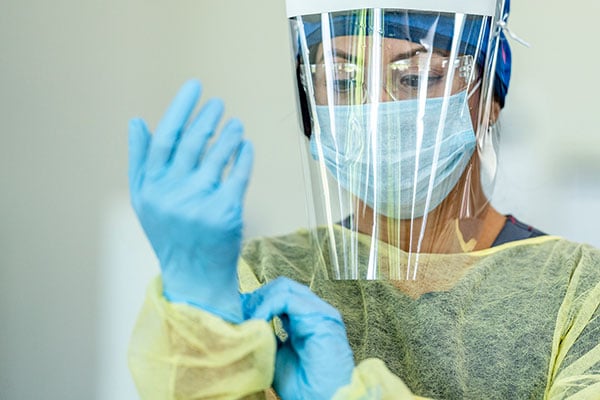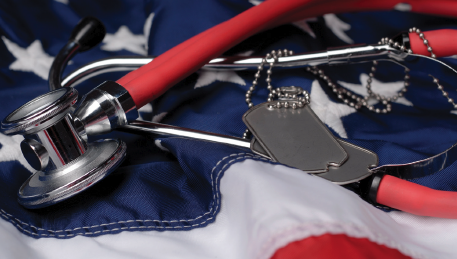COVID 19 Preparation + Care and Treatment Plan
A General Overview: (excerpts taken from EMCrit)
Appropriate gear
- N95 or equivalent (see PPE section of the COVID 19 Toolkit)
- Goggles, eye shield, face shield
- Gloves and gown
- Hair covering (scrub cap, surgical bouffant)
- Shoe coverings debatable – err on shoes that are easily cleaned.
Symptoms
- Most common: upper respiratory symptoms, lower respiratory symptoms, constitutional symptoms, fever
- Less common: 10-20% patients have GI symptoms (diarrhea, nausea) preceding common symptoms
- In elderly: “silent hypoxemia” which is hypoxemia and respiratory failure without dyspnea. For this reason it is very important to pay close attention to their O2 Sat levels regardless of how the patient may present.
- *Absence of fever is not exclusive
Labs
- WBC tends to be normal
- Lymphopenia has been seen in up to 80% of patients. Potential point of confusion is deciding on what WBC count should be the optimal cutoff.
- Significantly increased D-dimer and CRP
- Mildly increased procalcitonin
Quick facts regarding treatment and diagnosis
- Steroids (Dexamethasone) seem to reduce 28 day mortality – most recent evidence is in support (06/2020) (RebelEM & New England Journal of Medicine). See New England Journal of Medicine here.
- Remdesevir, if available, is associated with lower mortality for patients requiring low-flow (ineffective for patients needing high flow). Find article here.
- Venous Thromboembolism (VTE) is a major problem for patients that are admitted to the hospital ICU and general floor. Therapeutic dosing for anticoagulation is uncertain, be on the lookout for thrombosis. Find article here.
From EM Cases Website
- Chest X-ray findings (Cozzi D, Albanesi M, Cavigli E, et al.)
- Patchy, diffuse reticular-nodular opacities, and consolidations that can be basal, peripheral and bilateral predominance.
- Can use RALE score in emergency settings for correlation of extent of pneumonia and increased risk of ICU admission
- Point of Care Ultrasound (POCUS). Three key lung POCUS findings among patients with COVID-19:
- Numerous B lines emanating from “lumpy, bumpy”, irregular pleura. This is consistent with non-cardiogenic pulmonary edema
- Subpleural consolidations, often bilateral, with a liver-like appearance (“hepatisation”) of the lungs (representing lobar pneumonia)
- Absence of pleural effusions
- Rashes may occur in up to 20% of patients with COVID-19 and may aid in the diagnosis. Most dermatologic manifestations of COVID-19 are benign with the exception of that of distal ischemia
- Maculopapular rashes which may resemble pityriasis rosea
- Urticaria may affect a variety of locations of the body, but with sparing of the palm and soles and may be associated with more severe infection
- Vesicular rashes are similar to vesicles in chickenpox or disseminated zoster, but are a bit more scattered and discrete and less pruritic
- Petechiae and purpura are rare, but may be present with vasculitis or thrombocytopenia in the setting of COVID
- Chilblains most commonly affects the hands and feet, usually asymmetric red edematous +/- blistering, typically transient and affects younger patients
- Livedo racemosa is a web-like pattern of deep purple skin changes that can be diffuse, more commonly affects older patients, and may be associated with more severe infection
- Distal ischemia often begins as small, red or purple papules on the distal fingers and toes, becomes increasingly painful and eventually develops edema, bullae, and skin necrosis
COVID-19, A Deeper Dive
COVID Fundamentals
- COVID-19 (RNA virus) is part of the family of four coronaviruses which are widely distributed and can cause the common cold (but can also cause more severe illnesses like viral pneumonia in patients with comorbidities).
- Transmission: can occur via large droplet transmission (risk within 6 feet from infected patient). Controversial whether transmission can occur via an airborne route.
- Pathophysiology to consider:
- ARDS - characterized by diffuse alveolar damage
- Cytokine Storm - characterized by exuberant cytokine storm reaction with features of bacterial sepsis and hemophagocytic lymphohistiocytosis (HLH).
- PPE: Contact, droplet, airborne (with eye protection). Pay attention to the junction between gloves and gown, tuck them in leaving no gaps in-between. When removing PPE, first apply alcohol-based hand sanitizer to your gloves. After fully removing PPE, again use sanitizer to hands and wrists.
- COVID Stage of Illness
- Replicative: After infections, viral replication begins in the innate immune system without virus containment
- Adaptive Immune: The immune system starts to attack the virus and lowers virus titers. This may lead to increased levels of inflammatory cytokines, resulting in tissue damage and a sudden deterioration. Suggestive of a clinical phenomenon of virus-induced hemophagocytic lymphohistiocytosis where a patient gets infected and is relatively okay for several days then suddenly deteriorates.
- Neutrophil-toLymphocyte Ratio (NLR) Risk Groups
- Most useful prognostic factor affecting the prognosis for severe illness with 209-nCoV pneumonia. Early application of the NLR calculation and below risk group stratification with age allows patient classification management.
- Calculating the Neutrophil-to-Lymphocyte Ratio (NLR)
- NLR may be calculated using either absolute cell counts or percentages as shown here:
- Absolute # Neutrophils / Absolutele # Lymphocytes = Relative % Neutrophils /Relative % Lymphocytes
Precautions to consider in COVID19 Positive Patients
- Symptoms: Acute respiratory symptoms (cough, SOB) with or without a fever, nausea, vomiting, diarrhea, chest pain are possible. Arrhythmias, CHF, rhabdomyolysis/AKI can occur
- Timing: Symptoms 2-14 days after exposure. Rapid deterioration can occur more frequently in patients with heart disease, diabetes, lung disease, or older than 65 years old. Continued viral shedding in carries or survivors is unknown.
- Visitation: Restrict all visitors and non-essential providers
- PPE: Donning - washing hands, gown, gloves (tucked in), N95, eye/face shield. Doffing - hand hygiene with alcohol based sanitizer prior to removing gloves in room; gloves, gown, and eye/face shield are removed in room, hand hygiene again after N95 is removed outside the room. Be CAUTIOUS!
Lab Work Up:
- COVID-19 testing: Obtain upper respiratory nasopharyngeal swab (NP), oropharyngeal swabs (OP) may be collected if NP is unable to be collected. Sputum only collected for productive coughs, induction of sputum not recommended. Lower respiratory tract specimens testing if available is recommended. Maintain proper PPE when obtaining specimens.
- Nasopharyngeal swab: Insert a swab into the nostril parallel to the palate. Swab should reach depth equal to the distance from the nostrils to the outer opening of the ear. Leave the swab in place for several seconds to absorb secretions. Slowly remove the swab while rotating it.
- Oropharyngeal swab: Swab the posterior pharynx, avoiding the tongue.
- Respiratory Panel: coinfections are possible.
- Procalcitonin: High level suspect coinfection
- BMP: with Magnesium, Phosphate - watch for hypokalemia
- CMP: with differential - watch for lymphopenia and calculate NLR
- DIC labs: INR with PT/PTT, fibrinogen, D-Dimer
- Other: Ferritin, C-reactive protein, Ferritin, LDH, CK
- Troponin
- Triglycerides every 72 hours for patients on propofol
Medications (This is an overview of what has been used and what is being used currently. In no way are these recommendations. This is a list of what has been used to treat COVID19 for prophylaxis or treatment of currently diagnosed patients.)
- It is very important that you speak to your attendings regarding what medications are being used at your hospital to treat COVID19. There is a large amount of publications and studies arguing the benefits of antivirals and other medications. Here is a list just so that you are aware of what has been used and what is currently being used.
- Dexamethasone
- Fluids: Maintain a negative fluid balance. Low dose vasopressors to improve MAP.
- Antivirals:
- Chloroquine and Hydroxychloroquine, a polarizing topic currently, generally recommended against its use currently because of its lack of shown benefit and potential harmful side effects. https://www.nejm.org/doi/full/10.1056/NEJMoa2016638?query=recirc_mostViewed_railB_article
- Lopinavir/Ritonavir,
- none are FDA approved but are being used off label
- Antibacterials: Empiric antibiotics for bacterial pneumonia. Check/follow procalcitonin to help make clinical decisions for or against antibiotics. Follow CAP guidelines 2019 for patients not at high risk and no MDR risk factors.
Further Cited Sources
- https://www.medrxiv.org/content/10.1101/2020.02.10.20021584v1
- https://www.cdc.gov/coronavirus/2019-ncov/
- https://emcrit.org/ibcc/covid19/
- https://jamanetwork.com/journals/jama/pages/coronavirus-alert
- https://www.nejm.org/doi/full/10.1056/NEJMp2009457
- Cozzi D, Albanesi M, Cavigli E, et al. Chest X-ray in new Coronavirus Disease 2019 (COVID-19) infection: findings and correlation with clinical outcome. Radiol Med. 2020;125(8):730-737. doi:10.1007/s11547-020-01232-9
Related Content


Apr 09, 2021
Navigating the Military Match through COVID: A Perspective from Army Medical Students Vying for a Spot as an Emergency Medicine Resident in the Midst of a Global Pandemic
In a typical year, medical students commissioned in the United States Army, applying to match in emergency medicine, prepare to visit and interview at four programs spread across the country. This was not a typical year.





